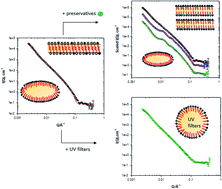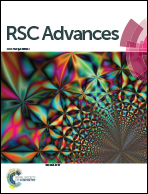Insights into the structure of sunscreen lotions: a small-angle neutron scattering study
Abstract
Sunscreen lotions and creams are arguably the most popular products used to protect the skin against harmful UV radiation. Several studies have been conducted to untangle the internal microstructure of creams and lotions. However, the effect of UV filters and other materials such as preservatives, on the internal microstructure and the aesthetics of these products is not yet fully understood. Using small-angle neutron scattering (SANS), we were able to investigate the effect of adding the commonly used organic UV filters (avobenzone (AVB), ethylhexyl methoxycinnamate (EMC), ethylhexyl triazone (EHT) and bemotrizinol (BMT)) and the water soluble preservatives (1,5-pentanediol (1,5-PD) and 1,2-hexanediol (1,2-HD)), on the internal architecture and microstructure of an oil-in-water (o/w) based sunscreen lotion. Our findings highlight the complexities of these formulations, and how the introduction of different additives could influence their structure and possibly their performance.



 Please wait while we load your content...
Please wait while we load your content...